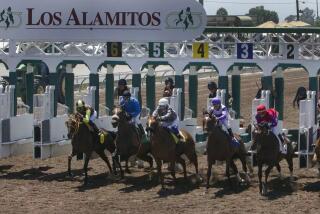Editorial: Fewer racehorses are dying — but still too many
- Share via
It’s been two years since Santa Anita Park started a tumultuous season of horse racing that saw 37 horses die from racing or training and ushered in a new period of reform in this risky sport. The alarming spate of deaths from late December 2018 to November 2019 led to an overhaul of the California Horse Racing Board and jump-started the federal Horseracing Integrity and Safety Act, which had been stalled for years in Congress. The bill, which passed last month, will put in place nationwide drug regulations and establish a national safety program.
The crisis focused attention on a society that still tolerates excessive drugging of horses and reckless stewardship by horse trainers. To its credit, Stronach Group — owner of the prestigious Santa Anita track in Arcadia — quickly instituted groundbreaking protocols including a phaseout of the ubiquitous race-day drug Lasix, a diuretic, and tough restrictions on various anti-inflammatory drugs that can dangerously mask a horse’s injuries. These new drug protocols are gradually being implemented statewide.
Santa Anita officials also added more veterinarians on-site and brought in two pieces of diagnostic imaging equipment including a PET scanner. And they wisely banned Hall of Fame trainer Jerry Hollendorfer from the park, in 2019, after four of his horses died at Santa Anita and two at Golden Gate Fields, which is also owned by Stronach Group.
Yet with all these protocols in place, death in racing has not disappeared. Santa Anita had 16 horse fatalities from training or racing from late December 2019 to mid-December 2020. That’s a fraction of the deaths the previous year and less than at various tracks across the country. But that number is still too high. The track has already had its first death of the new winter season — a 2-year-old colt, Ebeko, broke his left front leg racing and had to be euthanized.
However, the California track that fell under the harshest scrutiny in 2020 was Los Alamitos Race Course, which mainly races quarter horses (sprinters running short distances). The track had a total of 29 racing or training deaths over the racing year. The year-round racing track holds far more races per year than any other in the state.
The deaths alarmed the California Horse Racing Board, which in July put the track under a 10-day probation period and ordered it to come up with a safety plan. The board also created a detailed set of regulations for trainers, veterinarians and horses. But even under probation, two horses died. An additional seven died since the probation was lifted. Last month, the board granted the track only a six-month racing license for the start of the new season — instead of the one-year license the track usually gets. The board will reevaluate the track in July before deciding whether to reissue a license.
Of course, tracks can and should be more vigilant to make sure trainers and vets are complying with all the rules. But there is an inherent risk when a 1,100-pound animal runs nearly 40 mph on relatively small feet and lean legs. That risk can’t be reformed out of existence.
“Racing is always going to be dangerous for horses,” says Dr. Rick Arthur, veterinarian and equine medical director for the California Horse Racing Board. “They are high-speed. They race at the limit of their ability like Formula One cars.”
So here are some further reforms that should be put in place: All necropsies and fatality reviews on horses that die on California tracks should be posted publicly. The horse racing board already posts annual overall reports on fatalities and types of injuries, but even more transparency is called for.
There should be a central pharmacy on the grounds of larger race parks, and it should be the only source for medications coming into the park.
The PET scan imaging machine at Santa Anita should be used on more than horses exhibiting a problem. It should be regularly used on asymptomatic horses at some point before a race. Horses most often suffer catastrophic injuries in parts of their bodies that had previously been injured or had problems. Santa Anita might also wish to consider new technology, such as a 3D walk-in CAT scanner designed for horses.
If track owners and trainers want to keep racing horses, then they need to keep them from dying in the process.
More to Read
A cure for the common opinion
Get thought-provoking perspectives with our weekly newsletter.
You may occasionally receive promotional content from the Los Angeles Times.










